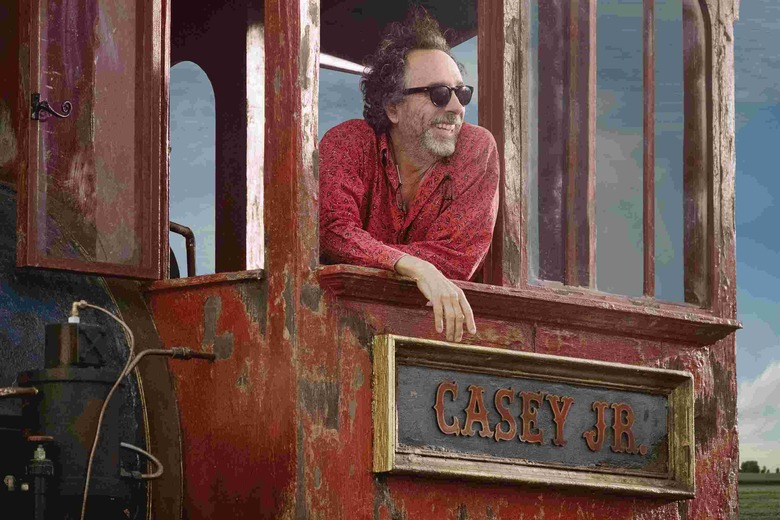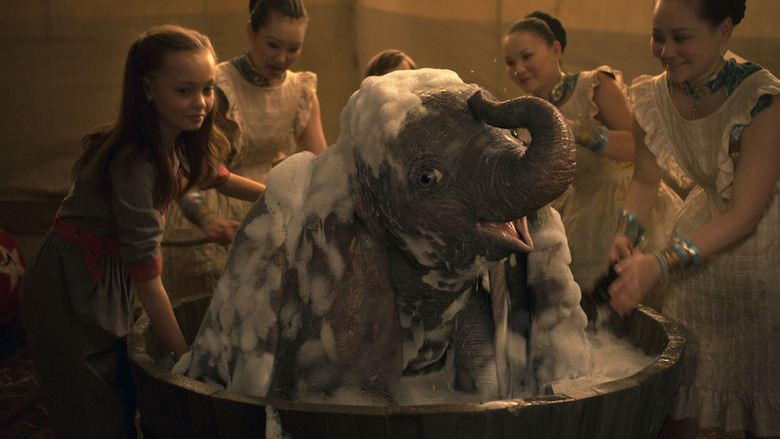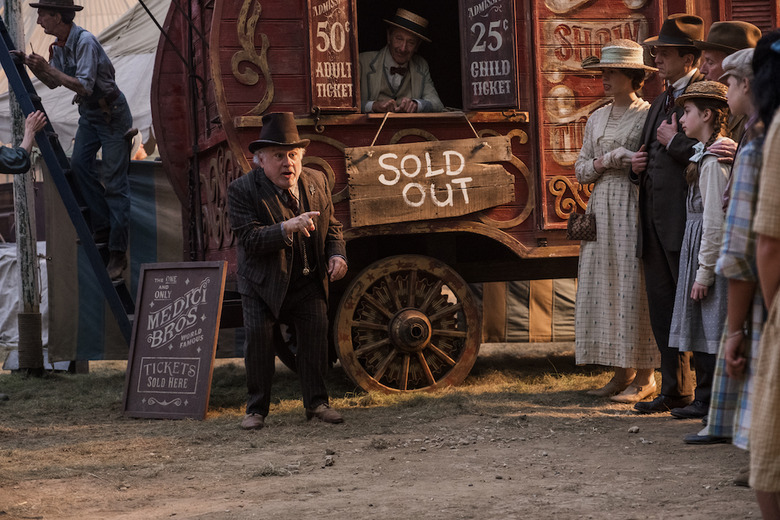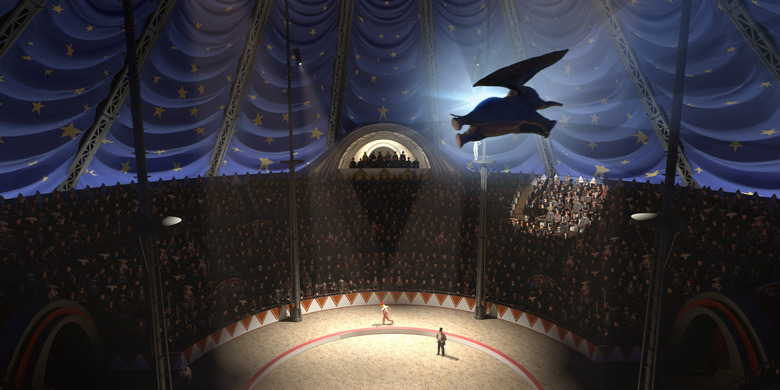How Going Family-Friendly Helped Tim Burton's 'Dumbo' Take Flight [Set Visit Report]
Tim Burton is distracted. He's in the middle of directing the live-action adaptation of Dumbo, an ambitious, big-budget production that requires balancing fantastical and elaborate sets with even more fantastical visual effects. But I got the feeling that this harried appearance was just part of Burton's nature — a million thoughts racing at once while he attempts to answer press questions. It's a surprisingly energetic persona from a man who is famous for donning all black and a dour complexion, but maybe that's why he always wears the grim color: he can't be bothered to think about anything else.
"It's hard for me to talk [about Dumbo] right now because I don't know if it's a comedy or a drama," Burton hurriedly tells us in between takes. "But I'll let you know when I'm done with it."
Hearing Burton refer to his Dumbo live-action adaptation as a comedy might be a bit confusing — humor isn't the first thing that comes to mind when one thinks about a Tim Burton movie, or the melancholic 1941 animated movie, either. But there is an unexpected warmth emanating from the Dumbo director and from the lavish, sprawling set around which he paces.
/Film got the chance to visit the set of Dumbo in London along with a group of other journalists, where I was immediately transported back into a storybook version of 1919. Here, a modest barn interior with a dirt floor and pieces of rope sits a couple hundred feet away from an elegant, Art Deco-style apartment decorated with vintage movie posters and marble floors. There, warm pinks and faded yellows adorn the backs of children running through a brightly lit town square.
And there isn't a Gothic Victorian castle in sight.
Tim Burton Sees the Light
Tim Burton's name has become synonymous with highly stylized, baroque films that largely put aesthetics before emotion. Even his last stab at a Disney live-action adaptation, 2010's Alice in Wonderland, received mixed reviews for its prioritization of lavish visuals over heart. But with Dumbo, it seems that heart is where Burton's, well, heart is.
"It's really nice to see the lightness of Tim that's always present in his films but because he's so known for the dark he gets tagged with that. But it's really not, this movie's a very light movie, it's very full of life, color, and joy," said costume designer Colleen Atwood, a frequent collaborator with Burton. Producer Derek Frey, another longtime collaborator, agreed.
"I think the difference with this is that he's choosing a palette that really is brighter, tonally it's brighter, it's warmer, it's more inviting. I don't know if that's a conscious thing, but I do think he looks toward the palette of the animated film for the foundation of this. Obviously, there are heavy and sad moments in the original, as there are in a lot of early Disney films, and that does provide a foundation for some of the emotional points in this film. But I wouldn't say that we're embedded in darkness, or murkiness, or fogginess. He's actually surprised me in the trajectory he's taken, that it is quite bright and inviting."
The 1941 Dumbo isn't particularly known for being a ray of sunshine. The animated film is quite infamous, in fact, for having some of the darkest and most frightening sequences in a Disney film to this day. The original film's story follows the semi-anthropomorphic elephant cruelly nicknamed "Dumbo," for his unusually large ears. Born to a circus elephant named Mrs. Jumbo, Dumbo is tormented by both human boys and fellow circus animals alike. But his sad existence is only worsened when his protective mom steps in, causing her to be thrown into a cage — leading to the film's famously heartrending "Baby Mine" sequence — and Dumbo to be left to his lonesome. Through a friendship with a sympathetic mouse, Timothy, Dumbo discovers that he has the power of flight and becomes a media sensation. The film was a touching, if traumatizing, touchstone of many a movie lover's childhood.
The original film's color palette served as one of the main sources of inspiration for Atwood's costumes. "The cartoon is really important to me as far as the telling of the story," Atwood said, adding that the warmer approach seemed to have brought out Burton's animation roots as well (the director got his start working as an artist at Walt Disney's animation studio). "When you look at Tim's movie... [it] is very, very based in animation and I think as a designer you have to anticipate that," she said. For Atwood, that meant more golds, pinks, turquoises — dirtied up to match the shabby traveling circus run by Danny DeVito's Medici, who first acquires Mrs. Jumbo and her newborn. And later on, bright, bold "red, white, and blue, which is very Americana," Atwood said of the destination circus Dreamland, run by Michael Keaton's slick businessman V. A. Vandevere.
"There's a storybook sort of feel [to the set]," said production designer Rick Heinrichs. Dumbo is filmed exclusively on stages, in elaborate sets that range from dusty American heartland to opulent circuses with "glittering spires" and Great Gatsby-inspired spectacle. "One of the decisions we made early on was that we were going to do this entire film on stage instead of [on location]," Heinrichs said, noting that this is the one aspect that would be familiar to Burton fans. "Being on stage allows you to focus more, and to light expressively and focus the audience's attention much more specifically, which, if you're familiar with Tim's movies, he loves to do."
The key to Dumbo, producer Justin Springer said, is striking that balance between Burton's signature visual style and the emotional resonance of the original film.
"You don't want to sidestep that feeling that you remember from the original. You want to capture that, it's really poignant and very memorable from all the classic Disney films. And then you just have to find ways to counterbalance that with the magic and joy of this elephant flying and the way the color palette is. So it's just about trying to find a balance where you have the highs and lows."
Family Steps Into the Spotlight
The 1941 film upon which Burton's Dumbo is based ran at 64 minutes — one of Disney's shortest animated features. To make the leap to live-action, Burton and screenwriter Ehren Kruger had to pad out the story with a new human element that didn't exist in the original film. That human element comes in the form of Colin Farrell, who plays Holt Farrier, a widowed war veteran and former star circus performer who returns to Medici's circus to care for his children and the new baby elephant. Holt's two young children, Milly (Nico Parker) and Joe (Finley Hobbins) are the ones who discover Dumbo's amazing ability of flight. While many Disney fans are understandably wary of different elements brought into classics, the story of Holt and his family plays perfectly into the original film's themes of family.
"The emotional core of the movie is twofold," Springer said. "One is still Dumbo's story: Him coming into this world and being different, and being looked down upon, and using this gift to create a better situation for himself. It's very much in the way the original film was, so you have to make sure you shoot it in the way that you get that emotionality. Then with the live-action movie, we have this father coming back to the circus, having just come out of the war. He used to be the lead actor in the circus, then he fought in the cavalry and is coming home to take care of his children but he finds out his act has been sold."
Farrell and his family provide the emotional throughline needed to bring Dumbo to modern audiences, Springer noted. With the universal themes of family, and the lavish historical setting, "it's a little bit for everybody," Frey added. Springer agreed, saying:
"So you're kind of in this human perspective simultaneously, and it's their story of discovery and this family putting together the pieces of their life again through their experience with Dumbo. Which is nice, because I think it opens up the movie to a wider audience, and when you do a live-action, you sort of need that human connection."
"Family...[is] really what this film is about," Heinrichs said. "Because Dumbo in our film, like the animated film in which there are a lot [of] similarities, he's kind of the prime motivator for a lot of the main characters." Whether that is to motivate the characters to respond with love and kindness, or to seek to exploit him, is the impetus for the movie. Which is where Keaton's P.T. Barnum surrogate, V. A. Vandevere, comes in.
Taking on the Turn of the Century
While the setting of the 1941 animated Dumbo was vaguely somewhere in the early 20th century, the 2019 Dumbo is set firmly in 1919...for the most part.
"Well, it's not a documentary," Atwood quipped. But Atwood and Heinrichs took the historical accuracy of the film seriously, diving into researching the fashion and architecture of the time period. Heinrichs looked at period architecture and photographs from just after the first World War, as well as the paintings of American realist painter Edward Hopper, whose famous oil painting "Nighthawks" is perhaps the embodiment of melancholic Americana. Meanwhile, about 90% of Atwood's costumes were authentic vintage dresses and menswear, tailored to fit modern-day bodies, with a few reproductions thrown in. But with the circus costumes, she allowed herself a little creative license.
"With the show costumes, the fantasy and the animation elements come into it more. So it's a combination of the feeling that Tim wanted with the costumes, with the patina of time. The guards there are kind of based on World Fair uniforms so it's pretty close but it's not precious. It's not that kind of movie."
The glamorous Dreamland circus, which is Vandervere's newfangled "destination circus" modeled off of Coney Island, is where Atwood and Heinrichs draw the distinction between historical accuracy and fantasy. A place that's "both Coney Island amusement park as well as circus and spectacle," Heinrichs wanted to create an over-the-top vision of the future that didn't exactly match with the more post-Victorian looks of the actual period. "We bent the rules a little bit and added '30s deco and some of the more futuristic shapes of World Fairs from the '30s," Heinrichs said. "We want this to feel like Oz to these yokels from the Heartland and quite over-the-top."
The divide between Medici's raggedy traveling circus and Vandervere's glitzy Dreamland also offered a central conflict for the film. "It's the Heartland vs. the Dreamland," Heinrichs said. "The Heartland wants to feel like your own family, the Dreamland is the big city, it's more glittering spires and surface spectacle. Medici's circus is more heart and family."
All About the Elephant
We've talked about everything but the most important character in Dumbo: the elephant. Dumbo presented a special hurdle for the crew, who had to not only structure the film around an entirely CG-animated character, but make him look as adorable as he's remembered in the 1941 animated film. Luckily, they didn't have to venture too far from the real thing.
"The original animated film is so cute and such a performance, but if you look at actual real baby elephants, they're not far off from that," Frey said. "They almost seem as if they're from an animated world, just how cute they are and how expressive they are. They feel like babies. So I think the reference for our Dumbo, it is kind of a cross between the original animated [character] and a real baby elephant."
Added Springer, "He has to kind of feel like he hits and exists in the real world, but maybe slightly cuter and more impressive."
But as cute as the real things were, there was still the issue of creating a realistic-looking baby elephant with giant ears that didn't look like an uncanny monster. The solution: start from square one. The visual effects team approached Dumbo's design "as if it were an animated cartoon," Heinrichs said. "And then we started to bring in more of the elements that felt real, and the idea that we're in a storybook because elephants don't really fly." But that line between fantasy and reality was something that the team had to constantly toe.
"The things that do need sell, is when we have any scene with any of our virtual actors, we want to believe it. You have to believe it. So you do need to take physics into consideration and the way things really look, but at the same time if you get too hung up with the reality of everything, you're almost undoing your work. It's a fine line, you keep going back and forth until you feel like you're getting into the groove."
However, being cute is just one part of being Dumbo. The elephant, who doesn't talk in either the 1941 animated or the 2019 live-action film, had to carry the emotional weight of the movie alongside Holt and his children. "We really wanted to make Dumbo not just look cute, but...that your heart was with him," Heinrichs said. That's an obstacle when the character is literally dumb, but Dumbo's perspective is "built into the movie" through Kruger's screenplay and Burton's camera work, Frey said.
"The thing is we try to keep Dumbo grounded other than when he takes flight. Obviously like in the animated one, it's not going to come easily to him, he's not going to nail this flight thing. There's going to be a bit of a learning curve. So to try to make that as real — if an elephant was born with big ears and could fly — the challenge was how to design an elephant with ears that are big enough that aren't ridiculous but that if he had control of them, what makes it look real so this elephant could carry that weight and take flight? So that makes it a bit of a challenge. But I feel like they're cracking it. You'll believe!"
Dumbo opens in theaters on March 29, 2019.




